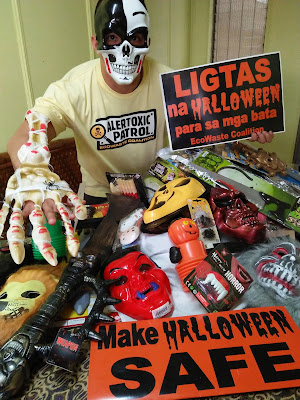Group Reminds Parents to be Cautious of Unsafe Halloween Toys
The
EcoWaste Coalition, a health and safety advocacy group, cautioned consumers
anew against Halloween playthings that may result in toy-related injuries,
especially if played without parental supervision.
The group made the warning after buying cheap Halloween toys from vendors in
Divisoria, Manila most of which have not
passed through the required quality and safety verification by the Food and
Drug Administration (FDA).
“There is no assurance that all toys being sold in the market are safe for our
children to play with,” lamented Thony Dizon, Chemical Safety Campaigner,
EcoWaste Coalition. “Some of these toys might be putting vulnerable kids
in harm’s way.”
Dizon warned that some toys may pose chemical, choking, fire, and laceration
hazards, and even blunt force trauma.
“Parents should only pick safe notified or registered toys for their children
and supervise them as they play to prevent any untoward incident,” he
suggested.
For this year’s Halloween celebration, the group bought 35 assorted Halloween
toys, including scary headbands and masks, imitation weapons, creepy hammers,
and "blood-stained" accessories like “blood saw in head,” “terrorist
necklace” and “horror blood and fangs.”
Notified or registered toys, as per FDA’s requirements, should bear the
following labeling information: license to operate (LTO) number, age grade,
cautionary statements/ warnings, instructional literature, item/ model/ stock
keeping unit (SKU) number, and manufacturer’s marking, including the complete
name and address of the manufacturer or distributor.
None of the 35 samples provided complete labeling information as required by
the FDA, which for the EcoWaste Coalition is a matter of serious concern as
this deprives consumers the right to know.
“Compliance to the labeling requirements is essential as this will equip
consumers with vital information on which to make their decision to buy a
product or not. In fact, toy manufacturers should also disclose the
chemicals present on a product and their effects, particularly to children’s
health,” emphasized Dizon.
Of the 35 samples, only eight have the required License to Operate (LTO) number
on their labels. In most cases, the information on LTO stickers was hardly
readable. “Parang ayaw ipabasa,” observed Dizon, saying that “a good
magnifying glass is needed to enable consumer to read the extremely fine
print.”
While 20 samples gave various hazard warnings, the warning symbols and
statements were ineffective because they were too small to get noticed, the
group observed.
Out of the 35 samples, the EcoWaste Coalition selected potentially hazardous
toys and described the hazards such toys posed, especially to young
children. For example:
1. A plastic imitation weapon measuring 35 inches in length with a
massive blade-like part that may cause blunt force trauma.
2. Toy axes and swords with sharp edges that can cause abrasions and
cuts.
3. Seemingly harmless devil headbands and light-up toys containing button
batteries that a small child may swallow, causing damage to the
gastrointestinal tract.
4. Costume masks adorned with fake hair that can easily catch fire, but
provide no fire hazard warning.
5. Some vampire-inspired accessories with matching “cosmetic blood” the
content of which is a mystery due to zero labeling information.
6. Accessories and toys with varying levels of lead content, including a
skull headband with 1,265 parts per million (ppm) of lead, way above the
allowable 90 ppm regulatory limit.
As the peak toy shopping season is upon us, the EcoWaste
Coalition reiterated the need for concerted action involving the government,
business and consumer sectors to uphold the right of all children to quality
and safe toys.
The group further advised consumers to observe the following tips to avoid
unsafe Halloween toys:
1. Carefully read the product label and refrain from buying unlabeled and
unregistered toys.
2. Choose toys that are suited to a child's age, ability and behavior.
3. Watch out for toys that may cause injury or pose burn, chemical,
choking, laceration, strangulation and other safety hazards.
4. Shun toys that have small parts such as button batteries and magnets
that can be pulled off and get swallowed by a child.
5. Steer clear of polyvinyl chloride (PVC) plastic toys that may contain
banned phthalates and other hazardous substances such as cadmium and lead.
6. Refrain from picking toys that have a strong chemical or perfumed
smell.
7. Avoid painted toys unless labeled as certified lead-safe.
8. Avoid face paints unless guaranteed free of toxic
metals and other cosmetic contaminants.
-end-







Comments